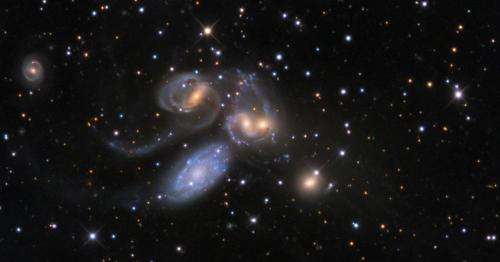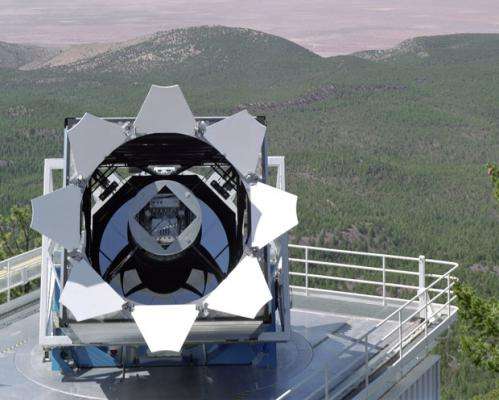A new, public view of the sky

For the first time, scientists and the public are beginning to see the large-scale structure of the universe, thanks to the Sloan Digital Sky Survey. UA scientists provide scientific expertise and crucial technology to the largest project ever undertaken to map the cosmos.
On Jan. 6, the Sloan Digital Sky Survey issued its latest public data release, the final release of the third epoch of the survey. Weighing in at more than 100 Terabytes, "Data Release 12" (DR12) contains measurements of the properties of nearly half a billion stars and galaxies, making it one of the largest and richest databases in the history of astronomy.
"The most astonishing feature of the SDSS is the breadth of ground-breaking research it enables," said Daniel Eisenstein of the Harvard-Smithsonian Center for Astrophysics, the director of SDSS-III. Eisenstein started the survey during his tenure as a professor at the UA's Steward Observatory, one of the survey's partner institutions.
"We've searched nearby stars for planets, probed the history of our Milky Way and measured nine billion years of our universe's accelerated expansion," he said.
SDSS-III is a six-year survey of nearby stars, the Milky Way galaxy and the distant cosmos. After a decade of design and construction, the SDSS began mapping the cosmos in 1998, using the dedicated 2.5-meter Sloan Foundation Telescope at Apache Point Observatory in New Mexico. Each phase of the project has used this telescope, equipped with a succession of powerful instruments, for a distinct set of astronomical surveys.
SDSS-III started observations in July 2008 and completed its six-year, $45 million program in June 2014. The SDSS-III collaboration includes 51 member institutions and a thousand scientists from around the world.
According to Xiaohui Fan, a Regents' Professor in the UA's Department of Astronomy and Steward Observatory who is involved in the project, some of the most interesting findings coming out of SDSS-III are measurements establishing the distance scale to faraway galaxies with unprecedented accuracy, gibing scientists a better handle on the properties of dark energy in the universe.
"SDSS-III was able to map the expansion history of the universe in a time frame never explored before—from nine billion years ago to now," Fan said. "These data confirm that what we observe is still consistent with our current model—that the universe is expanding and that it is expanding faster and faster."
Working with Steward Observatory assistant astronomer Ian McGreer, Fan is especially interested in the evolution of quasars and their connection to supermassive black holes. Quasars are the brightest objects in the distant universe, and their spectra reveal intricate patterns imprinted by the intergalactic gas and underlying dark matter that lie between each quasar and the Earth. Quasars provide another way to measure the distribution of matter in the universe.
"Because quasars are powered by the largest black holes in the cosmos, we can see them from very far away and use them to study the evolution of black holes and galaxies," Fan explained. "Most galaxies have a black hole in the center, but most of them are dormant. Only about one out of a hundred galaxies has a quasar at its center, which makes them shine very bright. It's an interesting question why some of them are bright and some of them aren't."
SDSS-III has devoted most of its 2,000 nights of observing to measuring spectra: passing light from individual stars and galaxies through a fiber-optic spectrograph, which divides light into component wavelengths much like a prism separates light into the colors of the rainbow.

"For each object that we observe, we're actually measuring several thousand light intensities at different wavelengths," said Jon Holtzman of New Mexico State University, which operates the observatory on behalf of the consortium. "We can then pick out the light produced by particular kinds atoms and molecules, which lets us measure the motions and chemical compositions of stars and galaxies."
"Mapping out the elements in a star is like reading its DNA," said Steve Majewski of the University of Virginia. "We're using those DNA readings to decode the history of the Milky Way from the stars that we can observe today."
Majewski is the principal investigator of APOGEE, or the Apache Point Observatory Galactic Evolution Experiment, one of the four surveys that comprise SDSS-III. APOGEE uses a dedicated near-infrared spectrograph consisting of 300-fiber-optical cables to survey giant stars across the Milky Way. The light sensors for the instrument were provided by a group led by Marcia Rieke, a Regents' Professor in the UA Department of Astronomy and Steward Observatory, as part of developing imaging sensors for NASA's James Webb Space Telescope.
"We repurposed three detectors that could not be used for JWST and built them into a package that is used as the light sensing portion of APOGEE," Rieke explained. "We are really pleased that these detectors are yielding great results."
By looking in near-infrared wavelengths to see through obscuring dust clouds, APOGEE has mapped the distribution of 15 separate chemical elements in more than 100,000 stars, probing all regions of the Milky Way.
"That's a huge amount of information," Majewski said, "and each element reveals a different subplot in this galactic screenplay. Sometimes the interactions between the characters are quite surprising!"
In addition to these elemental measurements from APOGEE, SDSS DR12 provides the first public release of data from MARVELS (the Multi-Object APO Radial Velocity Exoplanet Large-Area Survey). MARVELS uses repeated measurements of 3,000 stars to detect the back-and-forth motions that could reveal unseen orbiting planets.
DR12 also presents three-dimensional maps of cosmic structure traced by galaxies and intergalactic hydrogen from the Baryon Oscillation Spectroscopic Survey, or BOSS.
"With these maps we've detected the fossil imprints of sound waves that filled the universe during the first half-million years after the Big Bang," explained BOSS principal investigator David Schlegel of Lawrence Berkeley National Laboratory.
The BOSS team is using those imprints to trace the expansion of the universe across nine billion years of cosmic history, with unprecedented precision. Their final analysis, expected later this year, "will provide the sharpest test yet for theories of dark energy and the accelerating universe," according to Schlegel.
The Sloan Extension for Galactic Understanding and Exploration, or SEGUE, begun in SDSS-II and completed in SDSS-III, measured visible-light spectra of a quarter-million Milky Way stars.
"With so many stars, SEGUE gives us a great map of structure in the outer galaxy," said Constance Rockosi of the University of California, Santa Cruz, who led the SDSS-III component of SEGUE. "In combination with the much more detailed view of the inner galaxy from APOGEE, we're getting a truly holistic picture of the Milky Way."
Data Release 12 will fuel science analyses for years to come and makes all data available to the public.
"Crossing the DR12 finish line is a huge accomplishment by hundreds of people," Eisenstein said. "But it's a big universe out there, so there is plenty more to observe."
The Sloan Survey is continuing at full speed with SDSS-IV, which began in July 2014 on its six-year mission to study cosmology, galaxies and the Milky Way. Rieke's group provides near-infrared detectors for SDSS-IV, which will be used in a telescope at Las Campanas in Chile, the future site of the Giant Magellan Telescope, for which the UA is producing the primary mirrors.
"From the Southern Hemisphere, SDSS-IV will have a much better view of the center of our galaxy because it is right overhead instead of just barely above the horizon when viewed from New Mexico," Fan said. "In addition, we can observe the Large and Small Magellanic Clouds, the two largest satellite galaxies of our Milky Way, and learn a lot about the formation of our home galaxy and its neighboring galaxies."
Funding for SDSS-III has been provided by the Alfred P. Sloan Foundation, the Participating Institutions, the National Science Foundation and the U.S. Department of Energy Office of Science.
Provided by University of Arizona




















